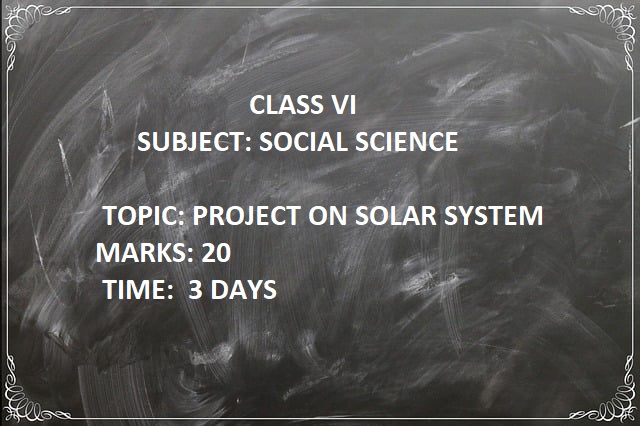Social Science Project On Solar System – Step by Step Guidance
Project on Solar System in just three days, impossible. This is the first thing that comes in our mind when we sit to complete a Social Science Project on Solar System in just three days. Most of us think that it is impossible to complete a Social Science Project on Solar System in just three days. It may seem like a daunting task, but with proper planning and organization, it can be done effectively.
Introduction:
The solar system, a vast and awe-inspiring cosmic neighborhood, captivates our imaginations with its celestial wonders. It is a fascinating and intricate system that comprises the sun, planets, moons, asteroids, comets, and other celestial objects, all bound together by gravity. Spanning billions of kilometers, the solar system offers a glimpse into the wonders of space and our place within it.
At the center of this celestial ensemble lies the sun, a blazing ball of gas that provides light, heat, and energy to the planets orbiting around it. The planets, including Mercury, Venus, Earth, Mars, Jupiter, Saturn, Uranus, and Neptune, each possess unique characteristics and mysteries waiting to be explored. Their diverse sizes, compositions, and atmospheres offer insights into the vast array of conditions that exist beyond our home planet.
Furthermore, the solar system boasts an array of moons, such as Earth’s companion, the Moon, and Jupiter’s Galilean moons, which exhibit diverse landscapes and geologic activity. Additionally, asteroids and comets, remnants from the early formation of the solar system, provide clues about its history and the potential for extraterrestrial life.
In this vast cosmic playground, humans have embarked on ambitious space exploration missions, aiming to unravel the secrets of the solar system. From the iconic Apollo moon landings to the ongoing exploration of Mars, our quest for knowledge and discovery continues to expand our understanding of the universe and our place within it.
In this article, we will delve deeper into the wonders of the solar system, exploring its various components, their characteristics, and the remarkable achievements of space exploration. Join us as we embark on an extraordinary journey through space and unlock the mysteries of our cosmic neighborhood.
7 Easy Steps To Complete Your Social Science Project On Solar System
Step 1: Research and Planning:
The first and most crucial step is to gather information about the solar system. Use books, reliable online sources, and educational websites to learn about the planets, their moons, the sun, and other celestial bodies. Take notes, highlight important details, and make a list of specific topics you want to cover in your project. This initial research will lay the foundation for your project and help you decide what aspects you’d like to focus on.
How to do research and planning to complete Project On Solar System
By following these research and planning guidelines, you will lay a solid foundation for your solar system project. Thorough research, careful organization of information, and a clear project plan will enable you to develop an engaging and informative project that captures the wonders of our celestial neighborhood.
Define Your Project Scope:
Begin by clearly defining the scope of your project.
Determine whether you want to focus on specific aspects of the solar system, such as planetary characteristics, space missions, or the sun, or
if you aim to provide a comprehensive overview.
Understanding the scope will help you gather relevant information and avoid getting overwhelmed with excessive details.
Gather Resources:
Utilize a variety of resources to gather information about the solar system.
Visit your local library to find books, magazines, and reference materials.
Explore reputable websites, educational platforms, and scientific journals to access up-to-date information.
Remember to critically evaluate your sources and ensure their reliability and accuracy.
Take Notes and Organize Information:
As you conduct your research, take detailed notes to capture important information and key facts.
Use a structured approach, such as creating a digital or physical folder system, to organize your notes, reference materials, and sources.
This will facilitate easy access to information during the project development stage.
Develop a Project Plan:
Create a timeline or schedule to plan your project’s progression.
Allocate specific time slots for research, writing, creating visuals, and finalizing the project.
Breaking down the tasks into manageable chunks will help you stay on track and complete the project within the given timeframe.
Establish a Research Framework:
To ensure a comprehensive approach, establish a research framework or set of guiding questions.
This will help you focus your research and ensure you cover essential topics.
For example, you may want to explore the formation of the solar system, characteristics of each planet, significant space missions, or the potential for life
beyond Earth.
Tailor your research questions to align with your project’s objectives and incorporate them into your note-taking process
Step 2: Select a Project Format:
Consider the various formats available for presenting your project.
It could be a written report, a visual presentation, a poster, or a combination of different formats.
Choose a format that suits your strengths and interests.
For example, if you enjoy graphic design, creating an eye-catching poster may be an excellent option.
Ensure that your chosen format aligns with the project requirements and time constraints.
How to select a Project Format?
Ultimately, the selection of a project format should be based on a combination of the project requirements, your strengths and interests, the suitability for
conveying information, the preferences of the audience, and the available time constraints.
By considering these factors, you can choose a format that allows you to present your research and findings in the most effective and engaging manner.
Step 3: Outline and Divide the Work:
Divide your project into smaller, manageable sections based on your chosen format.
Create an outline that includes an introduction, main points, and a conclusion.
Each section can focus on different aspects of the solar system, such as the planets, their characteristics, space exploration missions, or the importance
of the sun.
Distribute these sections across the three days, allocating sufficient time to research, write, and assemble the project.
How to Outline and Divide the Work while doing the Project On Solar System?
Identify Key Sections, Allocate Time for Each Section, Conduct Research for Each Section, Create a Logical Flow and Review and Refine the Outline.
By following these steps, you can effectively outline and divide the work for your solar system project.
This approach allows you to systematically cover the main topics, allocate time appropriately, conduct thorough research, and create a logical flow of
information.
With a well-structured outline in place, you will have a solid foundation to start developing the content of your project.
Step 4: Gather Visual Resources:
Visual aids play a crucial role in presenting information about the solar system effectively.
Collect images, illustrations, diagrams, and videos that will enhance your project’s visual appeal.
Make sure to credit the sources of your visual resources appropriately and obtain permission if necessary.
Compiling these resources in advance will save you time during the project’s execution.
How to gather visual resources for the project on solar system?
1.Utilize Online Sources
2. Visit Astronomy Websites and Magazines
3. Access Educational Videos and Documentaries
4. Check Libraries and Educational Institutions
5. Seek Permission and Provide Proper Attribution
Remember, visuals play a crucial role in enhancing the understanding and engagement of your project on the solar system. By utilizing a combination of online sources, astronomy websites, videos, physical resources, and respecting copyright regulations, you can gather a wide range of visually captivating materials to supplement your project effectively.
Step 5: Write the Content:
Begin writing the content for your project based on the outlined sections. Use your research notes and collected resources to provide accurate and
engaging information.
Present your findings in a clear and concise manner, making sure to cite your sources to maintain academic integrity.
Keep your language simple and accessible, as the purpose of a social science project is to convey knowledge to a broad audience.
What should be written in the content on the project on solar system?
Introduction:
Begin the content of your project on the solar system with an engaging introduction that grabs the reader’s attention.
Provide a brief overview of the solar system, highlighting its significance and the key topics you will cover.
2. Planetary Descriptions:
Dedicate sections of your project to describing each planet in the solar system.
Start with an overview of the planet’s basic characteristics, such as size, distance from the sun, and orbital period.
3. Moons, Asteroids, and Comets:
Explore the diverse array of moons, asteroids, and comets within the solar system.
Highlight significant moons, such as Earth’s Moon or Jupiter’s Galilean moons, discussing their characteristics, orbital dynamics, and notable features.
4. The Sun and Space Missions:
Devote a section of your project to the sun, the central star of the solar system.
Explain its importance in sustaining life on Earth and its role in the dynamics of the solar system.
Discuss key features of the sun, such as its layers, solar flares, and the solar wind
5. Significance and Future Exploration:
Conclude your project by emphasizing the significance of studying the solar system and its impact on our understanding of the universe and our place
within it.
Discuss the importance of ongoing space exploration missions, future plans for exploration, and the potential for discovering extraterrestrial life.
Remember to present the content in a clear and organized manner, using appropriate headings, subheadings, and visual aids to enhance comprehension. Incorporate scientific terminology when necessary, but also ensure that the language remains accessible to a broad audience. Cite your sources throughout the content to maintain credibility and allow interested readers to delve deeper into the topics you present.
Step 6: Create Visuals and Assemble the Project:
If your chosen format involves visuals such as posters or slides, use online tools or design software to create them.
Incorporate the images, diagrams, and videos you collected during your research.
Ensure that the visuals complement and reinforce the information you present in your written content.
If time permits, ask for feedback from peers or family members to improve the overall impact of your project.
How to create visuals and assemble the solar system project?
Determine Visual Elements:
Identify the specific visual elements you want to include in your solar system project.
This may include images, diagrams, charts, graphs, or even multimedia elements like videos or animations.
Gather Visual Resources:
Collect the visual resources you need for your project.
Use the research you conducted earlier to find relevant images, diagrams, or other visual materials.
Ensure that the visuals you choose are of high quality and accurately represent the solar system.
Create Visuals:
Depending on the nature of your project, you may need to create some visuals yourself.
Utilize design tools, such as graphic design software or presentation software, to create diagrams, infographics, or custom visuals.
Organize Visuals:
Determine the best way to organize and present your visuals within the project.
Consider the flow of information and how visuals can complement the text or narrative.
Use headings, captions, or annotations to provide context and guide the reader’s understanding.
Assemble the Project:
Finally, bring together the written content, visuals, and any other components of your project.
Use a digital platform, such as a word processor, presentation software, or design software, to assemble the different elements into a cohesive and
visually appealing final product.
Remember, visuals are a powerful tool for conveying information and capturing the attention of your audience. By following these steps, you can create engaging visuals and assemble them into a cohesive solar system project that effectively communicates the wonders of our celestial neighborhood.
Allocate time to review and proofread your project thoroughly.
Check for spelling and grammar errors, factual inaccuracies, and any inconsistencies in your content.
Ensure that your project flows logically and that the information is well-organized.
Make any necessary revisions and finalize your project, ensuring it meets all the requirements set by your teacher or instructor.
Conclusion:
Completing a social science project on the solar system in just three days requires efficient planning, focused research, and effective time management. By breaking down the project into smaller sections, utilizing visual aids, and presenting your findings in a clear and concise manner, you can achieve success within the given time frame. Remember to stay organized, be resourceful, and approach. By following the above mentioned steps, you can easily complete your project on solar system. Hope, this article provides an insight to complete your project on solar system.
You may be interested in:
Clear And Unbiased Facts About Project On Global Warming
Project On Green Energy: Securing Our Planet’s Future with Renewable Energy





0 Comments